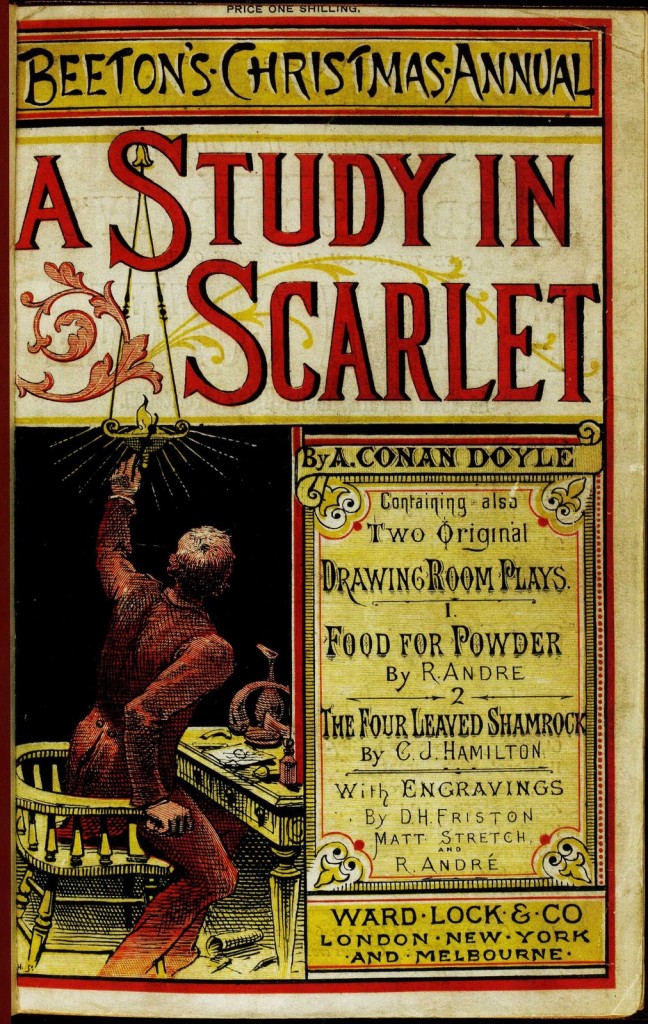
Returning to London from the Second Anglo-Afghan War (1878-1880), Dr. John H. Watson seeks a flatmate to share expenses. After a colleague introduces him to Sherlock Holmes, the pair rent a flat at 221B Baker Street. Watson finds Holmes curious, an enigma, but one morning, Holmes confesses to being a consulting detective. That same morning, a summons from Scotland Yard draws Holmes and Watson to a murder scene that Holmes later dubs “a study in scarlet.” So begins the Holmes-Watson friendship that have entertained readers, moviegoers, and television viewers for 128 years. It is also the beginning of A Study in Scarlet, the first of many stories that features Sherlock Holmes.
Though we best remember Sir Arthur Conan Doyle (1859-1930) as the creator of Sherlock Holmes, he lived a long and accomplished life. Born in Scotland, he raised himself from impoverished conditions to become a medical doctor. Though his first two practices failed, when he moved to London and adopted the specialty of ophthalmology, he succeed. He dabbled in politics and ran for Parliament twice, but lost both elections. His support of the Boar War (1899-1902) won him his knighthood in 1902. But in 1909, he wrote The Crime of the Congo to protest Belgium’s brutal practices in the Congo Free State. Doyle’s own criminal investigation led to the exoneration of two men falsely convicted of horrendous crimes. He married twice and had five children. He died on July 7, 1930 of a heart attack.
Doyle published four novels and fifty-six short stories featuring Sherlock Holmes. The short stories are collected into five books. Most of this work was first published by The Strand Magazine. Doyle grew to hate writing about Holmes, and he made several efforts to put Holmes behind him. He gave the detective a drug habit that he hoped would turn the public against him. He raised the price for these stories so high he expected the publisher would stop buying them. But The Strand met his price. In one story, he killed Holmes, but due to the public outcry, he resurrected Holmes a few years later. It is my intentions over the next few months to read and review one Sherlock Holmes book a month, in the ordered they were published as books. I begin with the first work, A Study in Scarlet, first published in Beeton’s Christmas Annual, 1887.
Compared to today’s crime novels, A Study in Scarlet (1887) is not an exciting book. But we shouldn’t judge it by today’s crime novels that have enjoyed almost two hundred years of evolution. If we think of Edgar Allan Poe’s “The Murders in the Rue Morgue” (1841) as the birth of the detective story, as many scholars do, then A Study in Scarlet is only a toddler. There had been a first few steps between these two detective novels, especially by Wilkie Collins (The Moonstone, A Woman in White). With his Sherlock Holmes series, Doyle help raise the crime novel from its infancy to its maturity. This opened the door for the whodunit novels by such writers as Agatha Christie and Dorothy L. Sayers and the hard-boiled detective novels by such writers as Dashiell Hammett and Raymond Chandler. Today the crime fiction genre has dozens of sub-genres from mystery to police procedural to legal thrillers. Collectively they make crime stories one of the most popular genre in the American literary market.
The Study in Scarlet surrounds the murder of Enoch Drebber, a wealthy American visiting London. His corpse was found in a vacant house. The killer had written the word RACHE in blood on the wall. Along with Holmes, two Scotland Yard detectives, Inspectors Gregson and Lestrade, investigate the murder. As these detectives follow their logical but false trails, Holmes and Watson return to their flat, where Holmes, with just a couple inquiries, solved the crime. Since Holmes arrests the killer halfway through the book, the story lacks suspense. The rest of the novel fills in the backstory of Enoch Drebber and his killer, so we understand the motive for the crime. The denouement deals with Holmes telling Watson, Gregson, and Lestrade his thinking process that led to the killer.
Though not exciting or suspenseful, The Study in Scarlet is entertaining. It serves as an introduction to Sherlock Holmes and his primary narrator, Dr. Watson, and helps us understand the principles of deduction, which Holmes uses in his investigation. My reason for reading this tale was because it introduces the Holmes canon. Since I had read–in a random way–other Sherlock Holmes novels and tales, I know as I move deeper into the canon, I will reach the tense, suspenseful, and thrilling crime stories we love.
I can’t wait!
